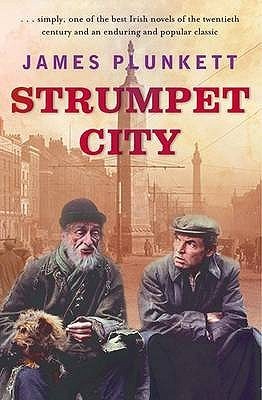■ James Plunkett, Strumpet City (London: Hutchinson, 1969)

The years from 1907 to 1914 are the subject of James Plunkett’s book Strumpet City. Set in this period before Irish independence, the collective hero of the novel is the working class, as it enters a new phase of its class struggle.
As a colonial subject, the bourgeoisie at that time was also directly dependent on Britain. Both the bourgeoisie and the clergy, who are represented in a variety of characters, take different positions on independence, although this was in their interest. Regardless, they broadly agree that they are in a class struggle against the workers and are themselves profiting from their misery.
Following the outcome of the War of Independence, this class, now in power, would confront the working class in a civil war. When it came to defeating the working class, the national question was of secondary importance to the bourgeoisie.
One important representative of the bourgeoisie in this novel is Mr Bradshaw, who owns some of the tenements and treats tenants and employees mercilessly. The police and the clergy support him in this. Although some elements within the bourgeoisie understand the absolute misery of the working class, they do not openly side with the workers, or question property relations. These characters include the Protestant company director Yearling and Mrs. Bradshaw, who is unable to stand up to her husband. The clergy hand out alms, unless the poor are in revolt, in which case alms are withheld. Yearling and Father Giffley can only endure the conflict between their compassion for the workers’ misery and their social position through excessive alcohol consumption.
On the side of the working class are Bob and Mary Fitzpatrick, Bernard Mulhall, the Hennessys, the Farrells, and Rashers Tierney, who vividly and authentically embody a comprehensive panorama of different stages of consciousness, ages, and circumstances. During the months of lockout, a new class solidarity develops among them. Their determined resistance against the employers brings them unimaginable destitution.
In the novel, the history and aftermath of the events are presented from the point of view of representatives of these different social classes. Although no individual “heroes” dominate, the characters are treated in a differentiated and sensitive manner. Each individual character reveals their class affiliation in their individual circumstances and viewpoints. The majority of workers arrive at a class standpoint through the strike. Pat Bannister expresses a broader socialist point of view. James Connolly, however, is mentioned only once in passing in the whole novel, by Bannister.
The lumpenproletariat includes Rashers Tierney, street musician and beggar, who occasionally finds work as an unskilled labourer. The Hennessys represent those who, concerned for their children, cannot withstand the pressure. But the majority of the dispossessed demonstrate a humanity and solidarity diametrically opposed to the values of the bourgeoisie.
When the ITGWU accepts the offer of solidarity from English workers to send Dublin children to England for the duration of the strike, the conflict among the clergy between Giffley and O’Connor comes to a head. O’Connor wants to stop this action at all costs, while Giffley sides with the workers’ families, understanding fully the relief this would bring. In 1913 this very plan was indeed prevented by the Catholic Church, on the pretext that Catholic children in England would be exposed to Protestant or atheist influences.
Plunkett creates crowd scenes in which readers experience the mood among the Dublin workers. An example of this is the scene in which the workers, led by Larkin, shut down Dublin Port in protest against the more than 160 strikebreakers brought in by a steamer from Liverpool. In this scene the Dublin proletariat is depicted at a crucial moment, where their leader, Larkin, emerges.
The power of the class is beautifully captured in the image of the stationary cranes and the ship bringing Larkin. Plunkett shows the masses at a moment of strength and confidence. This awareness and determination, despite all the setbacks, despite hunger and hardship, permeates the whole novel.
Readers get to know the Fitzpatrick family best. Bob was promoted to foreman through the influence of Mrs Bradshaw at his work-place. Yet, like Mary, he remains unwavering in his solidarity with the strikers.
Because Plunkett is unequivocally on the side of the working class in this novel, it is surprising that the conscious trade unionists at the centre of the plot have no connection with the Marxist Connolly, his political as well as his trade union work. Connolly is almost entirely left out. And although Larkin and some of the working-class characters are clearly socialists, there is also no mention of Connolly’s Irish Socialist Republican Party. The focus is on unionised struggle, without a theory that encompasses and goes beyond it.
In this way the novel obscures the fact that there were also political struggles for national independence and socialist liberation going on at that time. Thus, apart from the old housekeeper Miss Gilchrist, there are no nationalist voices among the workers. Plunkett’s workers show no obvious interest in national self-determination. And so the lockout appears to be purely a trade union struggle, at the expense of its role in the development of Irish revolutionary consciousness.
And while the founding of the Irish Citizen Army is mentioned, its further development and important role in the Easter Rising that followed only three years later is clear only to initiated readers.
Nevertheless, the book bears eloquent and inspiring witness to the strength of the Irish proletariat in one of their first great class struggles. It reveals to readers a class-consciousness that had yet to prove itself in the political liberation struggles that were then imminent—in the Rising, in the War of Independence, as well as in the Civil War, and which is still crucial today.
To the present day, many Irish people count Strumpet City among the most important and best books in Irish literature.






